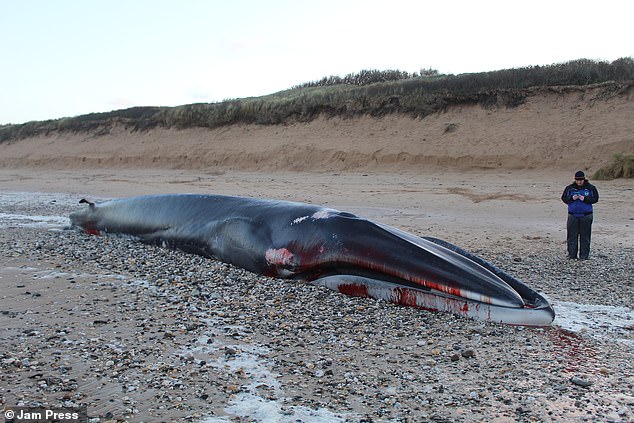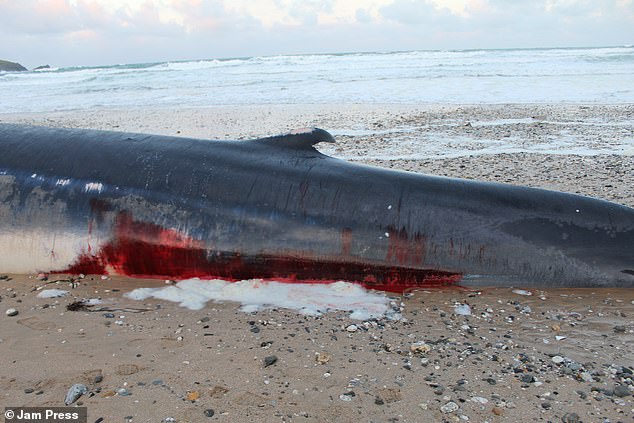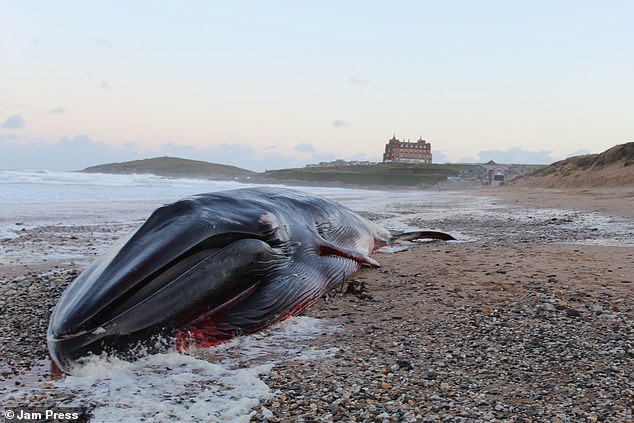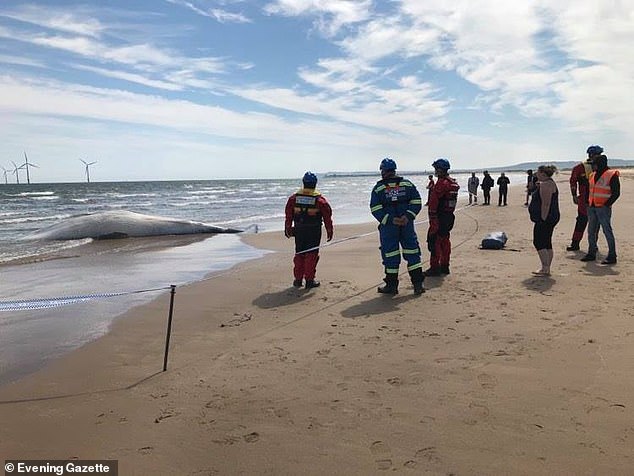Carcass of world’s second largest whale washes up on Cornwall beach as experts warn it is about to explode
Locals have been warned the carcass of a huge whale could explode after it was found on a Cornish beach this morning.
The mammal, found dead on Fistral beach in Newquay, was identified as a fin whale – the second largest in the world, measuring 17.5 meters in length.
Photos taken this morning show the whale stretched out on the sand, with what appears to be blood around its mouth, stomach and fin.
It is not clear what caused the mammal’s death, nor what caused the bleeding.
Some scratches can also be seen around the whale’s face.
A volunteer from the Marine Stranding Network at Cornwall Wildlife Trust said the mammal is at ‘high risk of blowing up’ and would be ‘very gassy and messy’.
Locals have been warned the carcass of a huge whale could explode after it was found on a Cornish beach this morning.

The mammal, found dead on Fistral beach in Newquay, was identified as a fin whale – the second largest in the world, measuring 17.5 meters in length.

Photos taken this morning show the whale stretched out on the sand, with what appears to be blood around its mouth, stomach and fin

A volunteer from the Marine Stranding Network at Cornwall Wildlife Trust said the mammal has a ‘high risk of blowing up’ and would be ‘very gassy and messy’.

The ‘snow tip’ of a minke whale’s dorsal fin seen in the Hebrides, pictured last month at the same spot the whale has frequented for 27 years
Hikers have been ordered to stay away from the carcass and the area has now been cordoned off by officials.
The scene was spotted by beachgoers and dog walkers, who can be seen standing next to the mammal on the shore.
In January, the remains of a fin whale were found on Perranuthnoe beach on the south coast of Cornwall.
In June 2022, a ‘baby’ whale was discovered on Millendreath beach near Looe in Cornwall.
in June 2021, a 40-foot minke whale carcass was spotted by a walker on the shore at a wind farm in Redcar, Teesside.
Experts were called to the scene to prepare for the removal of the marine mammal.
When a whale washes up on a beach, a large build-up of gas in their enormous frame means that it is often only a matter of time before they explode, sending their innards flying across the shoreline.
Colin Stonehouse, member of British Divers Marine Life Rescue, said: ‘When I arrived I checked to see if he was still alive but he had already passed away so we are going to take him in.
“We need to pull it back, get some data and find out the cause of death.”
He added that although the North Sea would be its natural habitat, it was not unusual for whales to come close to shore.
He added: ‘It could be navigational problems, there are a lot of bruises on it.
“It’s a female, a juvenile maturing, but I would have to measure the length to determine the exact age.”
Minke whales are the smallest of the ‘great whales’, growing to an average of 10.6 meters in length and weighing up to 9 tonnes.
They are also the most common of the large whale species and are found throughout the world’s oceans.

Emergency services deposit a minke whale carcass in Redcar, Teesside, in June 2021

It is believed that the minke whale can grow up to 12 meters in height and is usually seen in the North Sea
If a whale washes up on a beach, it’s only a matter of time before it explodes and its entrails fly across the shoreline.
When an animal dies, bacteria in the carcass produce methane as part of the decomposition process.
If this is not gradually released from the body, it builds up and explodes at the first opportunity.
Whales are the most extreme because their enormous size makes the consequences of a gas buildup so much greater.
In 2013, a biologist was filmed cutting open a beached whale in the Faroe Islands.
As soon as the biologist started working, the gas inside exploded, spewing tons of organs and viscera into the air.
